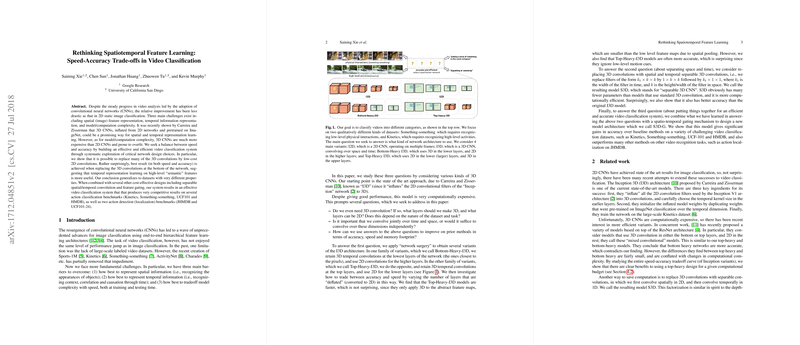Speed-Accuracy Trade-offs in Video Classification: A Reappraisal of Spatiotemporal Feature Learning
The paper "Rethinking Spatiotemporal Feature Learning: Speed-Accuracy Trade-offs in Video Classification" addresses the computational complexities and efficacy of spatiotemporal feature learning in video classification tasks. Despite advancements driven by Convolutional Neural Networks (CNNs) in image classification, video classification presents unique challenges that hinder comparable progress. This paper primarily targets the balance between computational efficiency and classification accuracy through a refined network design.
Challenges in Spatiotemporal Feature Learning
The paper identifies three core challenges in video classification:
- Spatial feature representation.
- Temporal information representation.
- Model and computational complexity.
The widely referenced I3D model introduced by Carreira and Zisserman, which inflates 2D convolutional layers into 3D, demonstrates potential in both spatial and temporal domains but remains computationally expensive and prone to overfitting.
Experimental Setup and Methodology
The authors systematically explore various architectural modifications of the I3D model, leading to significant empirical insights. Their approach incorporates:
- Bottom-Heavy and Top-Heavy Models: By altering the placement of 2D and 3D convolutions, the paper introduces Bottom-Heavy I3D (3D convolutions at lower layers) and Top-Heavy I3D (3D convolutions at higher layers) models. The Top-Heavy I3D models achieved superior speed and accuracy, contradicting the expected significance of low-level motion cues.
- Separable 3D Convolutions (S3D): Instead of merging spatial and temporal convolutions, the authors propose factorizing them into separate convolutions, significantly reducing computational load without sacrificing accuracy. This design leads to the S3D model, which demonstrated better performance and efficiency than the original I3D model.
- Feature Gating (S3D-G): Incorporating a spatio-temporal feature gating mechanism further enhances performance by effectively capturing interdependencies among feature channels.
The holistic approach combines these strategies resulting in the S3D-G model, an architecture that optimizes the trade-off between accuracy and computational efficiency.
Results
The modified architectures were evaluated on critical datasets such as Kinetics, Something-something, UCF101, and HMDB51. Key findings include:
- Performance Gains: The S3D and S3D-G models achieved higher accuracy with significantly reduced computational costs compared to I3D. For example, on the Kinetics-Full validation set, S3D-G outperformed I3D with a top-1 accuracy of 74.7% vs. 71.1%, while using fewer parameters (11.56M vs. 12.06M) and lower FLOPS (71.38G vs. 107.89G).
- Transfer Learning: S3D-G demonstrated strong performance when transferred to other datasets, such as UCF101 and HMDB51, achieving competitive results even against models pretrained on much larger datasets.
- Action Detection: In action detection tasks on JHMDB and UCF-101-24 datasets, S3D-G combined with Faster RCNN outperformed existing state-of-the-art methods, showcasing its applicability beyond classification.
Implications and Future Directions
The findings underscore the effectiveness of top-heavy and separable convolution designs in balancing computational efficiency and classification prowess. The integration of feature gating mechanisms further underscores the potential scalability and generalized application of these architectures.
Future research may investigate optimizing these models for real-time applications, adapting them to other modalities such as depth maps or LiDAR data, or extending their applicability to dense prediction tasks like semantic segmentation in videos. Additionally, exploration into hardware-accelerated implementations could further reduce computational demands, facilitating deployment in resource-constrained environments.
In conclusion, the paper presents a methodologically rigorous re-examination of spatiotemporal feature learning, contributing significant advancements in efficient video classification models. It addresses critical aspects of speed and accuracy trade-offs, presenting robust architectures adaptable to future AI developments in video analysis.
